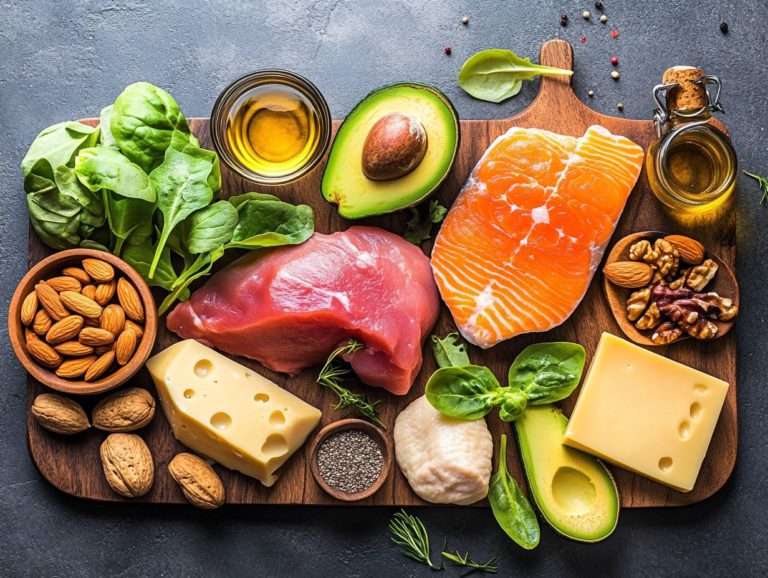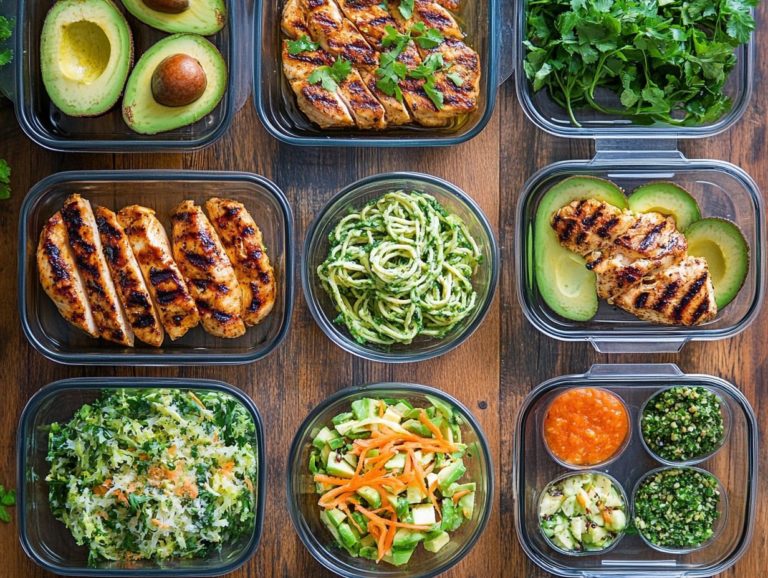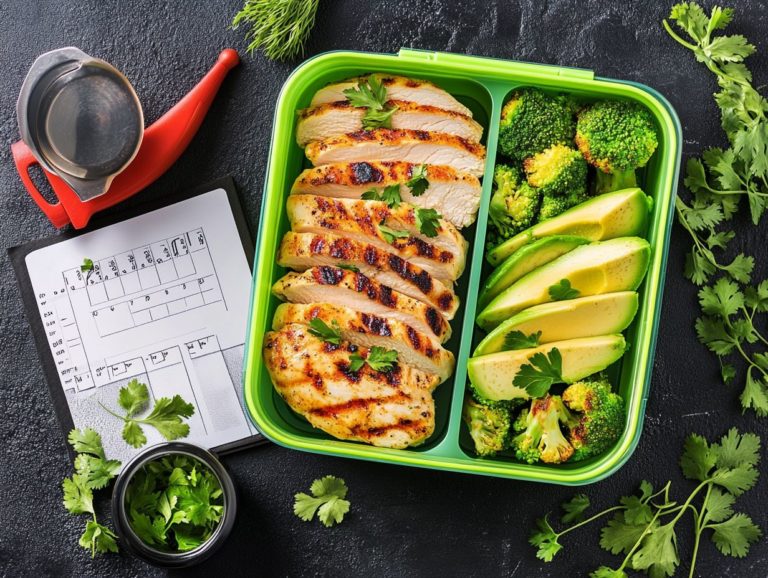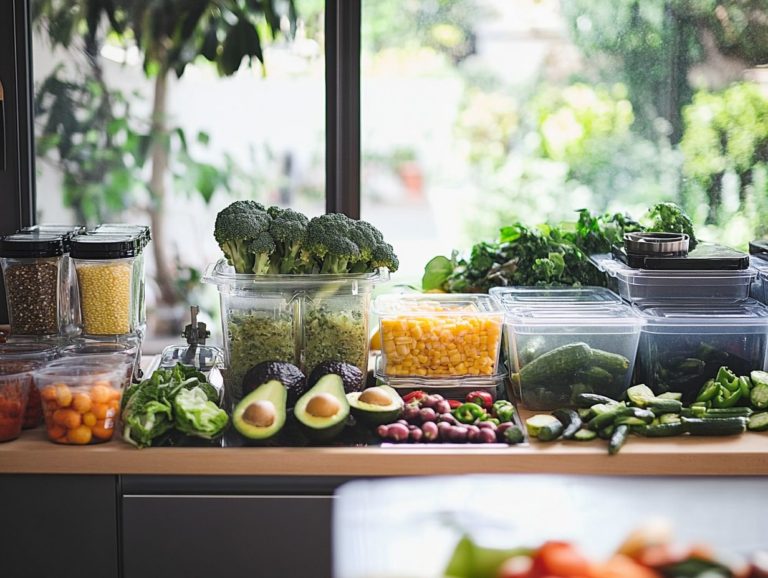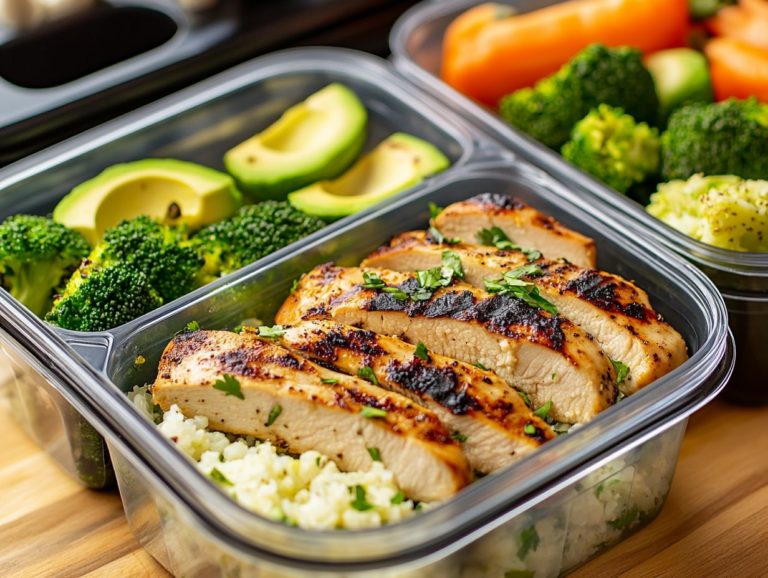Meal Prep Mistakes to Avoid on a Keto Diet
Meal prepping can truly revolutionize your experience on the keto diet, providing a structured approach to maintaining your macronutrient balance while also saving you precious time and minimizing stress throughout the week. By incorporating water intake and following dietary guidelines, you can further optimize your keto lifestyle.
Without careful planning and execution, it’s all too easy to stumble into common mistakes that can derail your progress.
This article underscores the significance of meal prep in a keto lifestyle, pinpoints frequent mistakes to sidestep, and offers invaluable tips to ensure your keto meal prep is not only effective but also enjoyable. Additionally, understanding the importance of hydration strategies can enhance your overall success.
Prepare to elevate your approach to keto and embrace a healthier lifestyle!
Contents
- Key Takeaways:
- Why Is Meal Prep Important for a Keto Diet?
- What Are the Common Mistakes to Avoid in Keto Meal Prep?
- Common Keto Meal Prep Mistakes to Avoid
- What Are Some Tips for Successful Keto Meal Prep?
- Frequently Asked Questions
- Avoid these common meal prep mistakes on your Keto journey!
- How can not planning ahead affect meal prep on a Keto diet?
- Why is it important to incorporate variety in Keto meal prep?
- How does not properly tracking macros affect meal prep on a Keto diet?
- What are the benefits of using high-quality ingredients in Keto meal prep?
- How can not properly storing food affect meal prep on a Keto diet?
- Why is adjusting portion sizes important for successful Keto meal prep?
Key Takeaways:
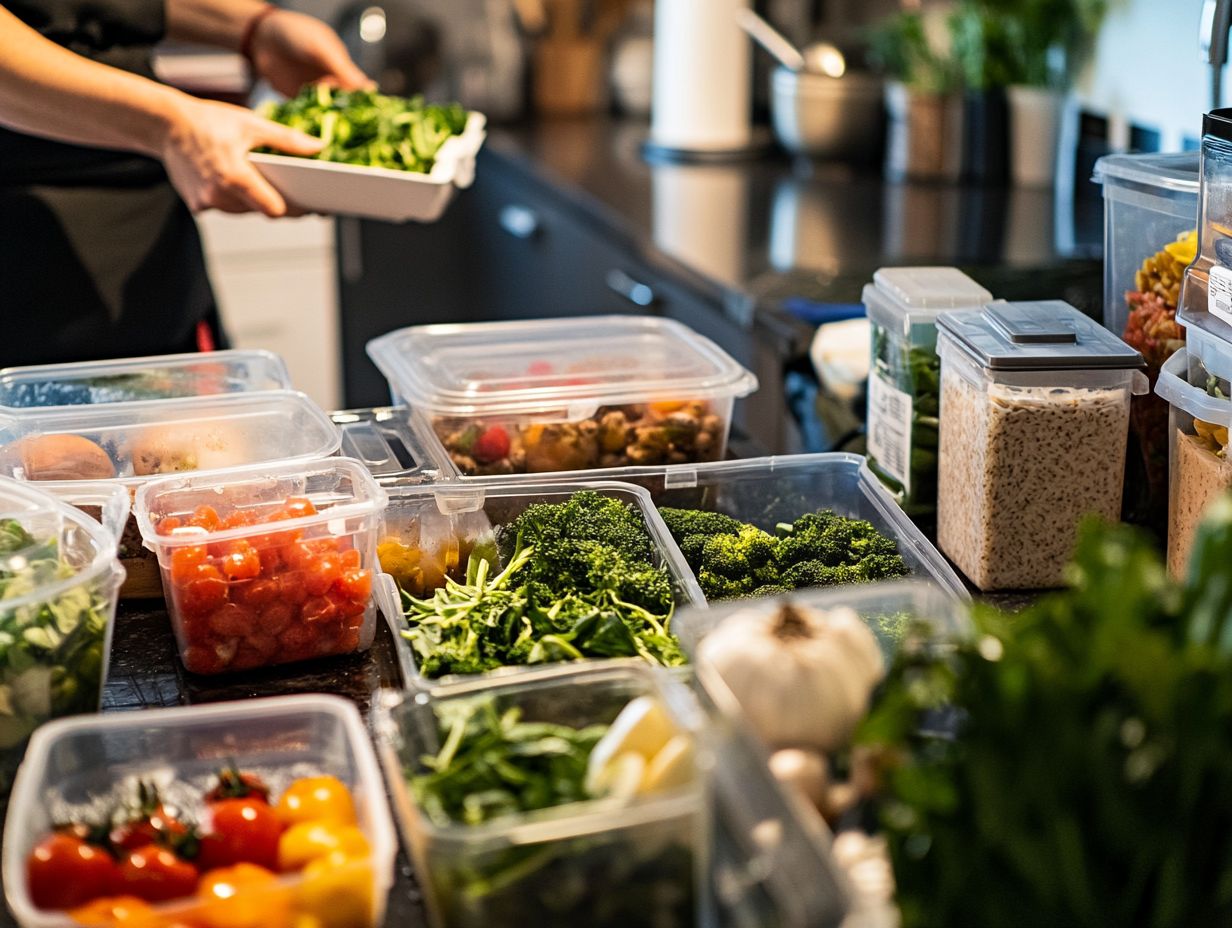
- Plan ahead and make a grocery list to avoid last minute decisions and impulse purchases. This can help you adhere to dietary guidelines and maintain food quality.
- Invest in quality meal prep containers to properly portion and store meals.
- Use a food scale to accurately measure portions and track macros and calories for successful keto meal prep.
Why Is Meal Prep Important for a Keto Diet?
Insights from Experts
According to registered dietitian Lynn Grieger, proper meal prep is crucial for maintaining a healthy keto lifestyle.
Meal prep is essential for anyone striving to maintain a successful keto diet. It aids you in sticking to your low-carb, high-fat eating plan while keeping your weight loss goals firmly in sight. As noted by Jessica Migala in Today’s Dietitian, planning meals ahead can significantly enhance your dietary adherence and outcomes.
By meticulously planning and preparing your meals in advance, you can manage your carb intake effectively, steer clear of the traps posed by processed foods, and sustain consistent energy levels throughout the day. Additionally, integrating nutrient-rich foods like healthy fats into your meals can further support your keto journey.
Meal prepping gives you better control over food quality, hydration strategies, and overall dietary adjustments. This preparation makes it significantly easier to tackle potential challenges like the keto flu and electrolyte balance. According to Alyssa Tucci from Cleveland Clinic, being mindful of these factors can enhance your diet’s effectiveness.
What Are the Common Mistakes to Avoid in Keto Meal Prep?
As you embark on your keto meal prep journey, it’s crucial to recognize the common pitfalls that could derail your success with the ketogenic diet. Neglecting to plan ahead or failing to spot hidden carbs lurking in food labels can result in nutrient deficiencies and disrupt your body’s transition into ketosis.
To navigate this path effectively, ensure you maintain a well-balanced intake of healthy fats, quality protein sources, and fiber-rich foods. This approach not only helps you avoid digestive issues but also supports your electrolyte balance, ultimately enhancing your weight loss journey. Incorporating omega-3 fatty acids and reducing vegetable oils can further improve your results.
1. Not Planning Ahead
One of the most significant mistakes you can make in keto meal prep is failing to plan ahead, which often leads to poor food choices and an increased reliance on processed foods.
Without a well-structured plan, you might find yourself reaching for convenience items that simply don’t align with your dietary goals. This tendency to opt for quick fixes can compromise the quality of your meals, making it crucial to prioritize thoughtful grocery shopping and ingredient selection.
By dedicating time to create a detailed grocery list that emphasizes whole foods, healthy fats, and low-carb vegetables, you can ensure that your meal prep is both nutritious and in line with your keto objectives. Exploring local markets for fresh produce and sourcing high-quality proteins can significantly elevate the success of your meal planning efforts.
Common Keto Meal Prep Mistakes to Avoid
2. Essential Tools and Equipment for Keto Meal Prep
Imagine whipping up delicious keto meals with ease! Having the right tools and equipment makes your meal prep not just easier, but a lot more enjoyable. Equipping yourself with the right tools is paramount for a successful keto meal-prep experience, as they can streamline your cooking process and enhance the consistency of your meal quality.
As you embark on your keto journey, investing in high-quality food containers becomes essential. These containers aid in portion control and storage, allowing you to effortlessly track your macros. Precision is crucial on this path, and that’s where measuring utensils like digital scales and measuring cups come in handy; they help ensure that you’re accurate with ingredient quantities, which is vital for adhering to the low-carb requirements of the diet.
Efficient cooking appliances, such as slow cookers or air fryers, can simplify your meal preparation, enabling you to create satisfying dishes that align perfectly with keto principles. A well-organized kitchen enhances cooking ease and elevates your meal prep experience. This enjoyment is key to sustaining a healthy lifestyle in the long run.
3. Not Considering Macronutrient Ratios
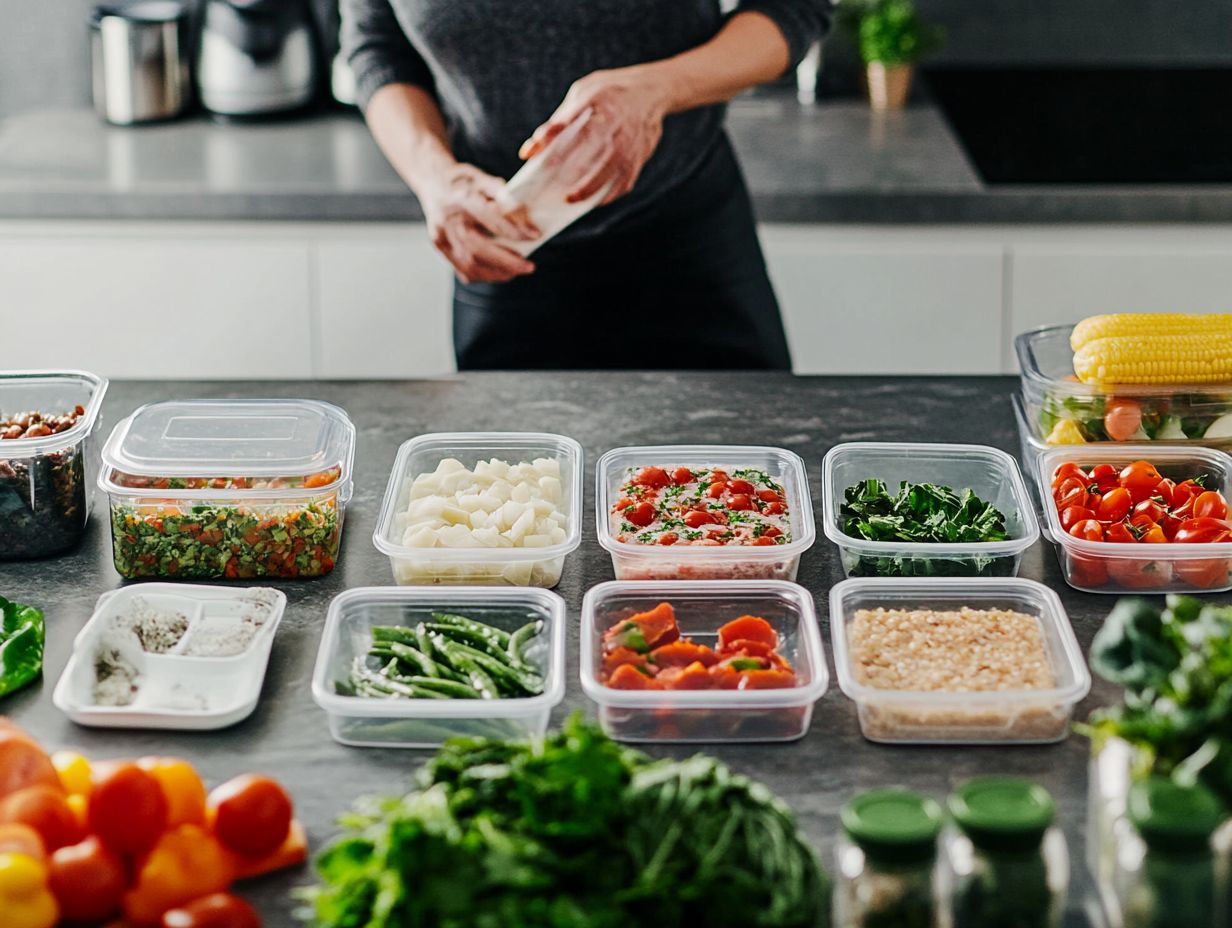
Ignoring macronutrient ratios can upset the keto diet’s balance, which is specifically crafted to encourage fat burning and promote ketosis through a high fat, low carb intake. Consulting with a registered dietitian can provide valuable guidance on maintaining these ratios effectively.
To navigate this dietary landscape successfully, you must pay careful attention to the proportions of fats, proteins, and carbohydrates in your meals. For instance, by incorporating avocados, olive oil, and nuts, you can significantly boost your healthy fat intake while also reaping essential vitamins and minerals. According to Harvard Health, these adjustments can provide a balanced nutrient profile.
Opting for high-quality protein sources like grass-fed beef, chicken, and fatty fish helps you maintain muscle mass and stabilize your energy levels. Including fiber-rich vegetables such as spinach, kale, and broccoli not only increases nutrient density but also supports your digestive health. Strategically balancing these elements ensures that your body receives the fuel necessary for sustained energy and overall well-being.
4. Not Varying Food Choices
Neglecting to vary your food choices in keto meal prep can lead to nutrient deficiencies and a rather dull eating experience, which isn t exactly the best way to keep your motivation high. Dive into a world of flavors by incorporating a diverse range of whole foods and healthy snacks into your keto regimen. This is crucial not just for maintaining enthusiasm for your diet but also for ensuring a well-rounded intake of nutrients.
By embracing a variety of ingredients, you can explore different flavors and textures, transforming your meals from mundane to delightful culinary experiences. This approach aligns with the recommendations of the Academy of Nutrition and Dietetics. Diversifying your meal planning allows you to enhance the nutritional value of your diet effortlessly. Different foods bring unique vitamins, minerals, and antioxidants to the table.
For instance, rotating between leafy greens, cruciferous vegetables, and healthy fats like avocados or nuts can create a richer tapestry of nutrients, ultimately supporting your long-term health and satisfaction. Consulting resources like the USDA guidelines can also help inform your choices. Don t wait to start your keto journey act now to transform your meal prep and enjoy delicious, healthy meals!
5. Not Properly Storing Food
Proper food storage is an essential element of successful keto meal prep, ensuring that the quality and safety of your meals are maintained while minimizing waste.
By adhering to best practices, you can preserve not just the delightful flavors but also the nutritional integrity of your dishes. Temperature control is paramount; it s best to cool prepared meals before refrigerating them to avoid condensation, which can encourage bacterial growth. Investing in high-quality, airtight containers is equally crucial, as they keep your meals fresh and prevent spoilage.
Incorporating strategies for moisture retention can elevate food hydration, enhancing both the taste and nutritional value of your meals. Keep in mind that well-stored meals not only offer a more enjoyable eating experience but also align with your overall health objectives. Adding sugar substitutes and cooking oils that comply with keto guidelines can further optimize your meal storage and preparation.
6. Not Portioning Meals Correctly
Not portioning your meals correctly can lead you down the slippery slope of overeating or undereating, ultimately undermining your keto meal prep efforts and the ketogenic diet itself.
Understanding the importance of precise portioning is essential for maintaining a balanced intake. It enables you to effectively track your macros and calories, ensuring that each meal supports your weight loss objectives while keeping your energy levels in check.
By measuring your food accurately, you can sidestep common pitfalls, such as unintentional calorie overload or insufficient nutrient intake, that could derail your progress. Utilizing tools like food scales and portion control containers simplifies this process considerably. As highlighted by Perfect Keto, these tools are essential for maintaining a successful ketogenic diet.
Moreover, integrating meal tracking apps into your routine allows you to monitor your daily intake effortlessly, providing valuable insights that align with your personal dietary goals. Proper portioning not only sustains your energy throughout the day but also fosters healthier eating habits in the long run. These apps often use data from reputable sources like StatPearls and the National Institutes of Health to provide accurate tracking.
7. Not Tracking Macros and Calories
Tracking your macros and calories is essential for maintaining a successful keto diet, as it keeps you aligned with your weight loss goals and dietary adjustments. Consulting with a registered dietitian or referring to resources from the American Heart Association can provide additional guidance on tracking effectively.
By meticulously monitoring your intake of carbohydrates, fats, and proteins, you can make informed choices that support ketosis and optimize your energy levels. Utilizing food labels becomes crucial in this process; they provide valuable information about serving sizes and macro breakdowns, empowering you to stay within your prescribed limits. Always consult medical supervision if you have any concerns regarding your dietary intake.
Various apps have emerged as essential tools, allowing you to log your meals effortlessly and track your macronutrient ratios in real-time. These strategic methods not only enhance your accountability but also foster a deeper understanding of your food choices and carb intake, ultimately leading to greater success on your keto journey and overall weight loss.
What Are Some Tips for Successful Keto Meal Prep?
Successful keto meal prep is all about employing strategic tips that elevate your experience and give you the power to maintain your ketogenic lifestyle with finesse. By planning ahead and crafting a meticulous grocery list, you can guarantee that you have all the right ingredients at your fingertips, making it a breeze to whip up meals that align perfectly with your desired macronutrient ratios and dietary adjustments.
Additionally, investing in high-quality meal prep containers and utilizing a food scale to accurately measure your portions will not only streamline the process but also enhance the quality of your meals and ensure a balanced intake of nutrients and micronutrients.
1. Plan Ahead and Make a Grocery List
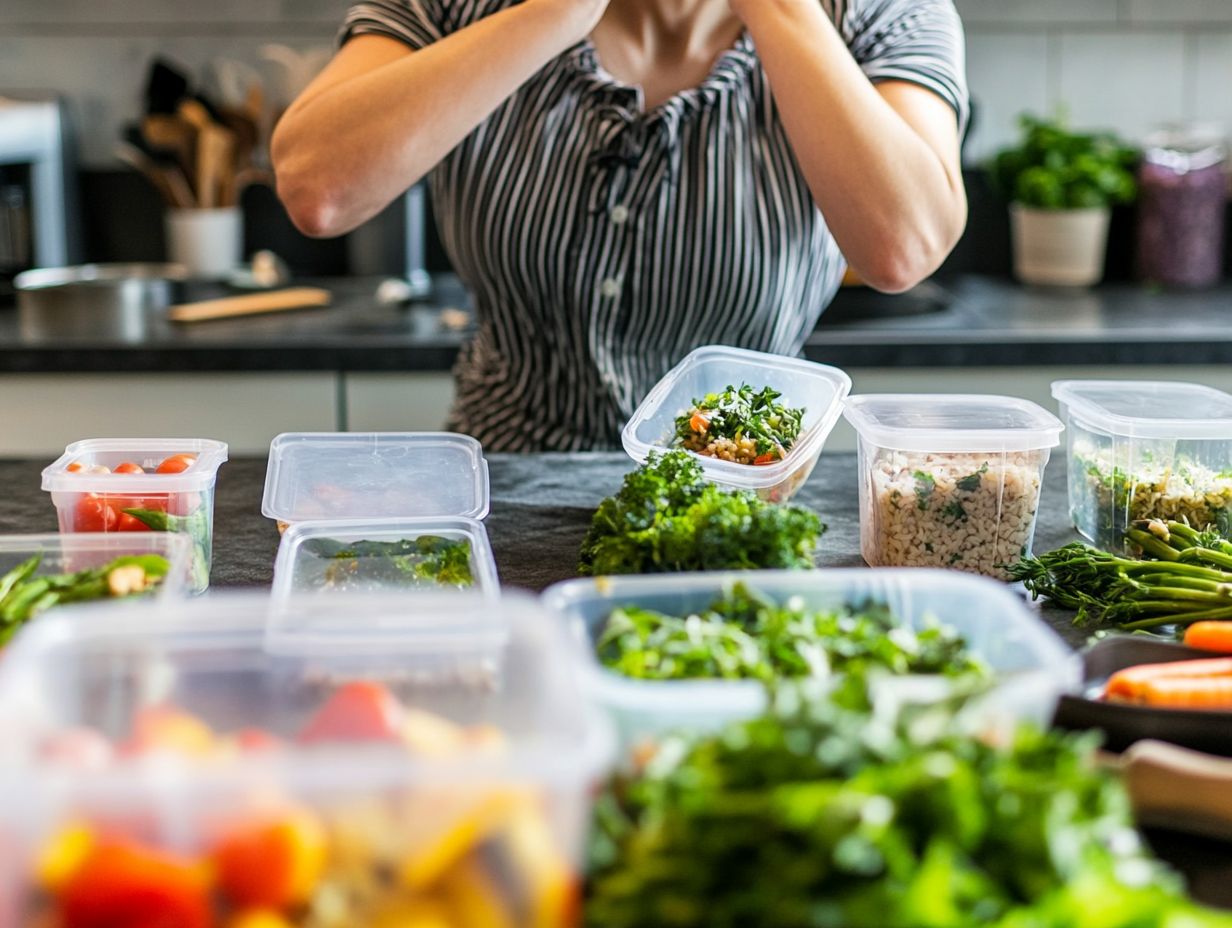
Creating a grocery list and planning your meals in advance is a crucial step in the keto meal prep process. This ensures you have all the necessary ingredients while significantly reducing those tempting impulse purchases and hidden carbs.
Not only does this practice promote better organization in your kitchen, but it also increases your chances of sticking to your dietary goals. With the keto diet’s strict guidelines, having a clear plan is essential to sidestep the allure of high-carb foods that could easily hinder your progress. This is especially important in the early stages when keto flu symptoms may appear.
By taking the time to craft a nutritious menu and a thorough shopping list, you can strategically select items that align with your dietary needs. Ultimately, this fosters a more focused and successful approach to your low-carb lifestyle while ensuring food quality and avoiding processed foods.
2. Invest in Quality Meal Prep Containers
Investing in high-quality meal prep containers is essential for preserving the freshness and quality of your keto meals. This makes storage and reheating a breeze.
You ll find a variety of meal prep containers available, each tailored to meet unique needs. For instance, glass containers are fantastic for their durability and are often microwave-safe. On the other hand, BPA-free plastic options are lightweight and perfect for your on-the-go lifestyle.
If you lean towards sustainability, stainless steel containers offer an eco-friendly choice. Selecting the right type not only elevates your meal prepping experience but also saves you precious time during your hectic week.
Opting for containers with compartments allows you to keep your ingredients separate. This ensures that flavors stay distinct and makes portion control easy, which is crucial for tracking the right balance of carbs, fats, and proteins.
3. Use a Food Scale to Measure Portions
Utilizing a food scale to measure your portions with precision is an essential asset for successful keto meal prep. It enables you to track your macros effectively, ensuring you stay aligned with your dietary goals and avoid overeating, which can impede your weight loss efforts.
When you know the exact amounts of carbohydrates, proteins, and fats in each serving, you can adeptly manage your daily intake and make well-informed food choices. This level of precision amplifies the effectiveness of your keto diet by preventing overconsumption.
Regularly using a food scale gives you the power to achieve better portion control. This results in enhanced energy levels and more favorable weight loss outcomes. With additional tools like food diaries and tracking apps, measuring your food accurately can lead to significant progress in achieving and maintaining your desired results on your low-carb journey. Consulting with a registered dietitian can further optimize your approach.
4. Experiment with Different Recipes and Ingredients
Dive into the world of keto-friendly recipes to make meal prep exciting and delicious! Experimenting with various ingredients can truly elevate your experience, making it easier to adhere to the ketogenic diet while delighting your taste buds.
Incorporating omega-3 fatty acids and avoiding vegetable oils can enhance the nutritional value of your meals. By including a diverse range of healthy fats think avocados, nuts, and olive oil alongside a bounty of whole foods like leafy greens and vibrant vegetables, you can significantly enhance your culinary journey.
Exploring innovative cooking techniques, such as sous vide or air frying, enriches the flavors and helps preserve the nutrients in your dishes. This transforms everyday meals into delightful culinary adventures, allowing you to maintain your dietary goals while enjoying vibrant, nutritious ingredients.
Embrace this flavorful journey towards health and discover new favorites that foster a lasting commitment to a balanced lifestyle. This ensures you re not just following a diet but thriving on nutrient-rich foods that energize you!
5. Store Food Properly and Reheat Safely
Proper food storage and reheating techniques are vital for you to maintain the quality and safety of your keto meals, preventing spoilage while ensuring that delightful flavors are preserved. These practices also help in avoiding common mistakes related to food prep.
Be mindful of temperature guidelines. Keep your food stored at or below 40 F to keep those pesky bacteria at bay. Regarding reheating, make sure your meals reach an internal temperature of at least 165 F. This not only guarantees safety but also helps to maintain the integrity of your carefully selected ingredients.
Selecting the right containers can also make a significant difference in your meal prep journey. Opt for glass or BPA-free plastic containers, as they resist odors and stains, making them ideal for your culinary creations. By adhering to these best practices, you’ll enjoy your meals without compromising on quality, convenience, or taste!
6. Track Macros and Calories to Stay on Track
Effective tracking of your macros and calories during keto meal prep is essential for staying aligned with your weight loss goals and ensuring a well-rounded intake of nutrients. This practice prevents digestive issues and helps manage fiber intake effectively.
Not only does tracking help you maintain the right balance of fats, proteins, and carbohydrates, but it also gives you the power to make informed food choices throughout your day. Consider utilizing various tools, such as mobile apps like MyFitnessPal or Cronometer, which offer user-friendly interfaces for logging your food intake and monitoring macro distribution. With extensive food databases at your fingertips, these apps simplify the tracking process, allowing you to adjust your meals effortlessly to meet your dietary needs.
By consistently monitoring your intake, you gain valuable insights into how your food choices affect your overall health and progress on the keto diet. Consulting resources from the National Institutes of Health and USDA can provide additional guidance on maintaining a healthy keto lifestyle.
Frequently Asked Questions
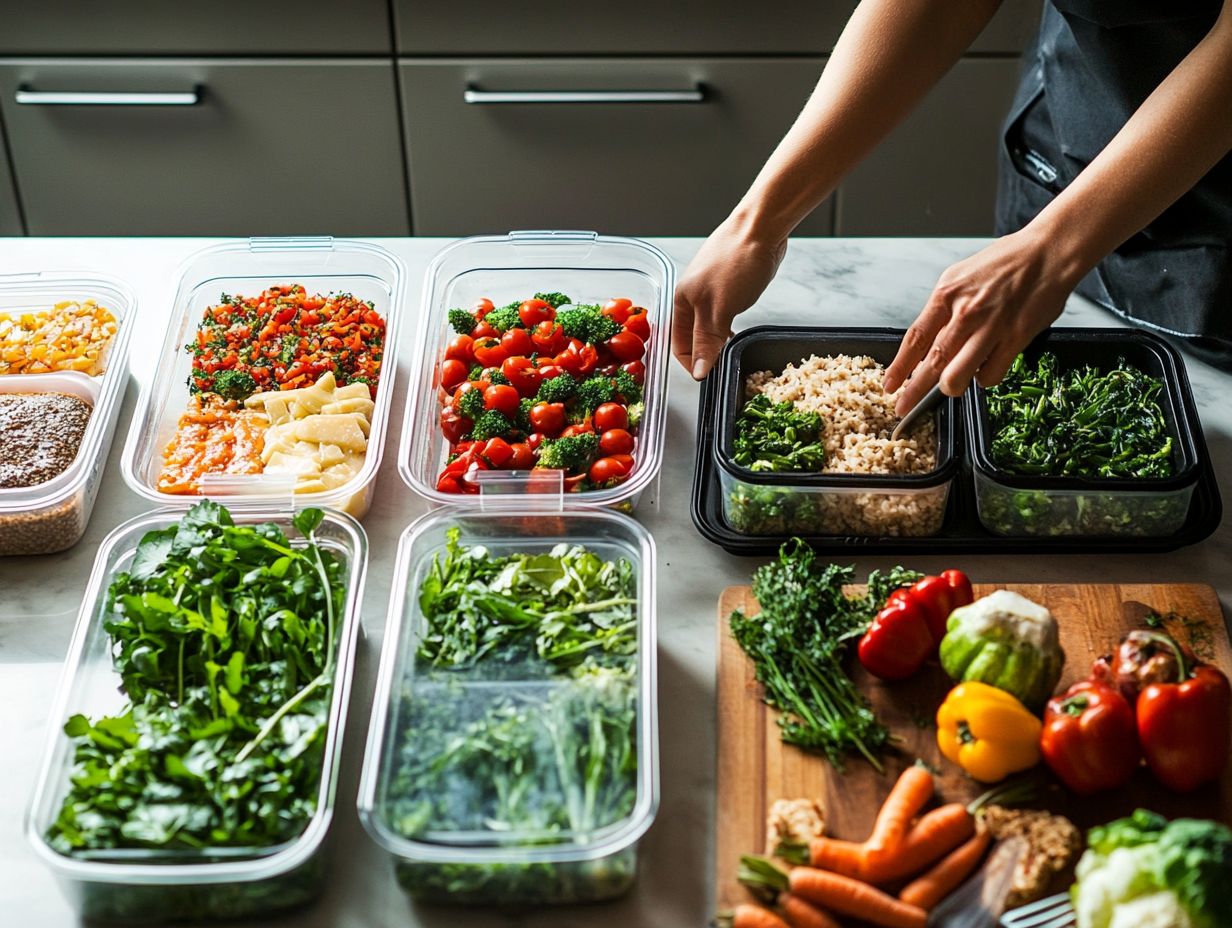
Avoid these common meal prep mistakes on your Keto journey!
Common meal prep mistakes to avoid on a Keto diet include not planning ahead, not incorporating enough variety, not properly tracking macros, not using high-quality ingredients, not properly storing food, not adjusting portion sizes, and not paying attention to sugar substitutes and processed foods.
How can not planning ahead affect meal prep on a Keto diet?
Not planning ahead can lead to not enough Keto-friendly options readily available, resulting in making poor food choices and potential cheating on the diet. This can also lead to not enough time to prepare meals properly, leading to feeling overwhelmed and stressed, and potentially disrupting your ketosis.
Why is it important to incorporate variety in Keto meal prep?
Incorporating variety is important on a Keto diet to ensure you are getting a balance of nutrients and avoiding boredom with your meals. Eating the same foods repeatedly can lead to nutrient deficiencies and make it more difficult to stick to the diet.
How does not properly tracking macros affect meal prep on a Keto diet?
Not properly tracking macros can result in unintentionally going over your daily carbohydrate limit, which can kick you out of ketosis. This can happen if you are not accurately measuring ingredients or keeping track of portion sizes. Reviewing food labels and being mindful of hidden carbs can assist in more accurate tracking.
What are the benefits of using high-quality ingredients in Keto meal prep?
Using high-quality ingredients can help ensure you are getting the most nutrients out of your meals and can also improve the taste and overall satisfaction with your meals. It is also important to choose organic, grass-fed, and pasture-raised options whenever possible. These choices can provide better sources of omega-3 fatty acids and other essential micronutrients.
How can not properly storing food affect meal prep on a Keto diet?
Not properly storing food can lead to spoilage and wasted resources. Use airtight containers and follow food safety guidelines to keep your meals fresh and safe.
This practice prevents digestive issues and maintains the quality of your prepared meals.
Why is adjusting portion sizes important for successful Keto meal prep?
Adjusting portion sizes is essential to avoid overeating and consuming excess calories. This is crucial for weight loss on a Keto diet.
It s vital to listen to your body and modify portion sizes as needed to feel satisfied. Consulting with a registered dietitian can help align portion sizes with your health goals.

